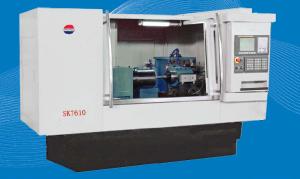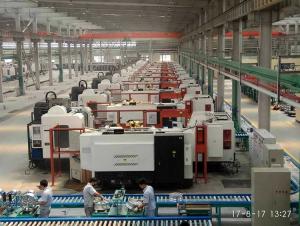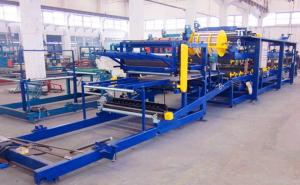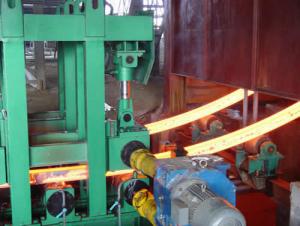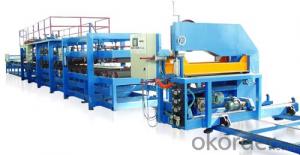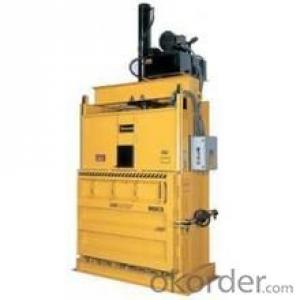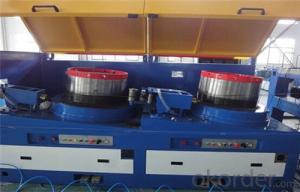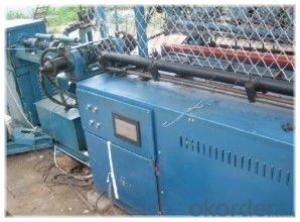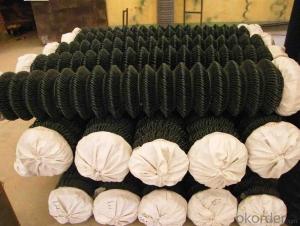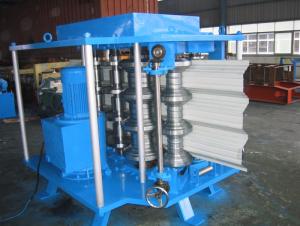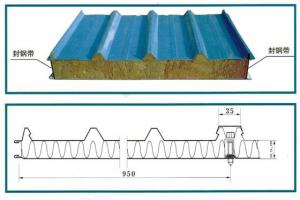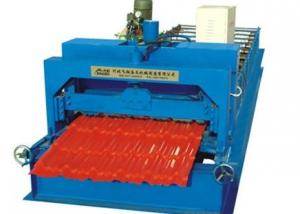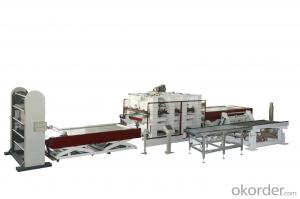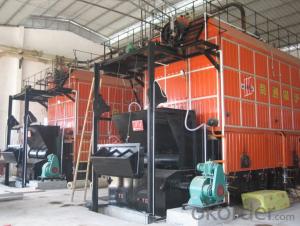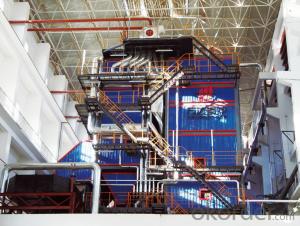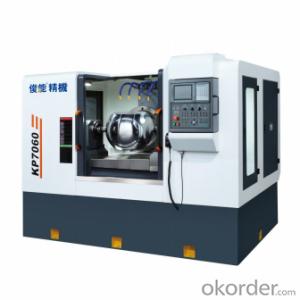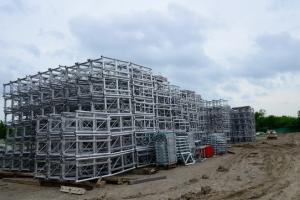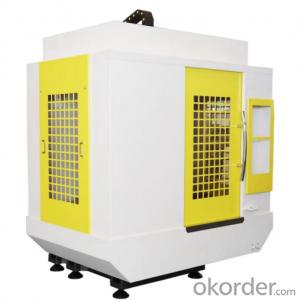CNC machine tool is the abbreviation of Computer numerical control machine tools.
- Loading Port:
- Tianjin
- Payment Terms:
- TT or LC
- Min Order Qty:
- 1 set
- Supply Capability:
- 1000 set/month
OKorder Service Pledge
OKorder Financial Service
You Might Also Like
CNC machine tool is the abbreviation of Computer numerical control machine tools. It is an automatic machine tool equipped with a program control system. The control system can logically process the program specified by the control code or other symbolic instructions, decode it, express it with coded numbers, and input it into the numerical control device through the information carrier. After the arithmetic processing, various control signals are sent by the numerical control device to control the movement of the machine tool, and the parts are automatically processed according to the shape and size required by the drawing.
CNC machine tool solves the problem of complex, precise, small batch and multi-variety parts processing. It is a flexible and efficient automatic machine tool. It represents the development direction of modern machine tool control technology and is a typical mechanical and electrical integration. Chemical products.
Main Advantage
The operation and monitoring of the CNC machine tool are all completed in this CNC unit, which is the brain of the CNC machine tool. Compared with ordinary machine tools, CNC machine tools have the following characteristics:
1. Strong adaptability to the processing object and the characteristics of single-piece production of molds and other products, providing a suitable processing method for the manufacture of molds;
2. High processing accuracy and stable processing quality;
3. Multi-coordinate linkage can be performed, and parts with complex shapes can be processed;
4. When the processing parts change, generally only need to change the CNC program, which can save production preparation time;
5. The machine tool itself has high precision and rigidity, and can choose a favorable amount of processing and high productivity (generally 3 to 5 times that of ordinary machine tools);
6. The high degree of machine tool automation can reduce labor intensity;
7. Conducive to the modernization of production management. CNC machine tools use digital information and standard codes to process and transmit information, and use computer control methods, laying a foundation for the integration of computer-aided design, manufacturing and management;
8. Higher requirements for the quality of the operating personnel and higher technical requirements for the maintenance personnel;
9. High reliability.
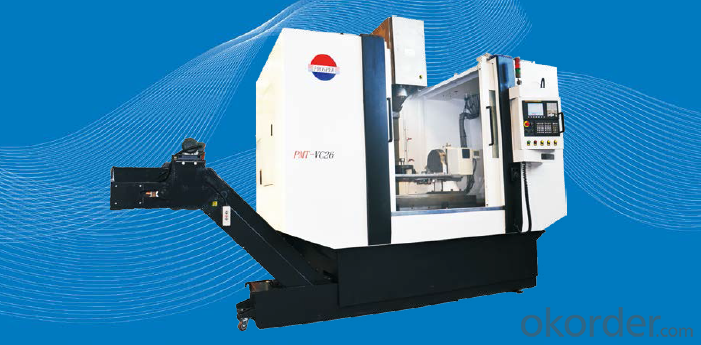
CNC machine tool is an automatic machine tool equipped with a program control system, which can make the machine tool move and process parts according to the programmed program. It integrates the latest technology of machinery, automation, computer, measurement, microelectronics, etc., and uses a variety of sensors. The sensors used in CNC machine tools are mainly photoelectric encoders, linear gratings, proximity switches, temperature sensors, Hall sensors, current Sensors, voltage sensors, pressure sensors, liquid level sensors, resolvers, induction synchronizers, speed sensors, etc., are mainly used to detect position, linear and angular displacement, speed, pressure, temperature, etc.
1. The requirements of CNC machine tools for sensors
1) High reliability and strong anti-interference;
2) Meet the requirements of accuracy and speed;
3) Easy to use and maintain, suitable for the operating environment of the machine tool;
4) Low cost.
Different types of CNC machine tools have different requirements for sensors. Generally speaking, large machine tools require high speed response, and medium and high precision CNC machine tools mainly require accuracy.
2. Application of inductive synchronizer
Inductive synchronizers are made using the principle that the mutual inductance of two planar windings varies with position. Its function is to convert the angle or linear displacement into the phase or amplitude of the induced electromotive force, which can be used to measure the linear or angular displacement. According to its structure, it can be divided into linear type and rotary type. The linear induction synchronizer is composed of fixed length and sliding scale. The fixed length is installed on the machine bed. The sliding scale is installed on the moving parts and moves with the worktable. The stator of the rotary induction synchronizer is a fixed disk and rotor. For spinning discs. The induction synchronizer has the advantages of high precision and resolution, strong anti-interference ability, long service life, simple maintenance, long-distance displacement measurement, good manufacturability and low cost. Rotary induction synchronizers are widely used in turntables of machine tools and instruments and various rotary servo control systems.
- Q:Can metal engraving machinery be used for engraving on brass?
- Certainly, brass can indeed be engraved using metal engraving machinery. Brass, being a metal alloy mainly composed of copper and zinc, is often chosen for its visual attractiveness and is frequently employed for decorative purposes. Metal engraving machinery is specifically designed to engrave on a wide range of metals, including brass. This machinery employs diverse techniques, such as rotary engraving or laser engraving, in order to produce intricate and accurate designs on the brass surface. Thus, these machines offer the capability to engrave text, images, or patterns onto brass, rendering it an adaptable choice for personalized or decorative endeavors.
- Q:What are the different types of engraving software used with metal engraving machinery?
- Metal engraving machinery commonly utilizes various types of engraving software to control and operate the machinery, enabling precise and intricate designs to be engraved onto metal surfaces. One commonly used engraving software is CAD/CAM software, which stands for Computer-Aided Design/Computer-Aided Manufacturing. This software allows users to design and create custom engravings using computer-aided design tools. The designs can then be converted into machine-readable code that the engraving machinery can interpret and execute. CAD/CAM software is highly versatile and offers a wide range of design options, making it popular among professional engravers. Another type of engraving software is laser engraving software. Laser engraving machines use a laser beam to etch designs onto metal surfaces. The accompanying software enables users to import and manipulate designs, adjust laser settings such as power and speed, and control the movement of the laser beam. Laser engraving software often includes features like image editing tools, vectorization capabilities, and the ability to generate machine-readable code for precise engraving. Some metal engraving machinery also incorporates rotary engraving software. Rotary engraving machines use a rotating cutting tool to engrave designs onto metal surfaces. The accompanying software allows users to input designs, specify cutting parameters such as depth and speed, and control the movement of the cutting tool. Rotary engraving software may also offer features like text formatting, image manipulation, and the ability to create customized templates. Additionally, there are specialized software programs available for specific types of metal engraving, such as jewelry engraving software. These programs are specifically designed to meet the unique requirements of jewelry engraving, offering features like gemstone modeling, ring sizing tools, and compatibility with various precious metals. In conclusion, the various types of engraving software used with metal engraving machinery offer a range of features and capabilities to meet the specific needs of engraving professionals. Whether it's creating intricate designs using CAD/CAM software, achieving precise laser engraving with laser engraving software, or utilizing rotary engraving software for rotary engraving, these programs enable engravers to produce high-quality and detailed engravings on metal surfaces.
- Q:What are the benefits of using metal engraving machinery?
- Metal engraving machinery offers several benefits in various industries. Firstly, it allows for precise and detailed engraving, ensuring high-quality and professional results. This is particularly important in industries such as jewelry making, where intricate designs need to be engraved on metal surfaces. Secondly, metal engraving machinery enables faster production, increasing efficiency and reducing lead times. Additionally, it offers versatility, as it can be used on a wide range of metals, including stainless steel, brass, and aluminum. Furthermore, the durability of metal engravings ensures long-lasting markings, making it ideal for applications that require permanence, such as serial numbers or identification plates. Overall, the benefits of using metal engraving machinery include accuracy, efficiency, versatility, and durability, making it a valuable tool for many industries.
- Q:What are the different types of metal engraving machinery?
- There are several different types of metal engraving machinery available in the market today, each designed to cater to specific needs and requirements. These machines vary in terms of their capabilities, features, and the level of automation they offer. Some of the commonly used types of metal engraving machinery include: 1. Pantograph engraving machines: These machines use a mechanical tracing system that follows a template or pattern to engrave metal. They are typically used for simple designs and are manually operated. 2. CNC engraving machines: Computer Numerical Control (CNC) engraving machines are more advanced and versatile. They use computer-controlled movements to engrave metal with precision. These machines can handle complex designs and can be programmed to create intricate patterns. 3. Laser engraving machines: Laser engraving machines use laser technology to engrave metal surfaces. They offer high precision and can create detailed designs with fine lines and intricate patterns. Laser engraving machines are often used for industrial applications and can engrave a wide range of metals. 4. Rotary engraving machines: Rotary engraving machines use a rotating cutting tool to engrave metal. They are versatile and can handle various materials and shapes. These machines are commonly used for personalizing items like jewelry, trophies, and nameplates. 5. Impact engraving machines: Impact engraving machines, also known as dot peen engravers, use a stylus to create small marks or dots on the metal surface. They are ideal for marking serial numbers, logos, or other identification marks on metal objects. 6. Hand engraving tools: While not technically machinery, hand engraving tools are still widely used for metal engraving. These tools include gravers, chisels, and hammers that are manually operated to create designs on metal surfaces. Hand engraving allows for a high level of artistic expression but requires skill and precision. The choice of metal engraving machinery depends on the specific requirements of the project, the level of precision needed, and the desired outcome. It is important to consider factors such as cost, speed, complexity of designs, and the volume of work when selecting the suitable type of machinery.
- Q:Can a metal engraving machine be used for engraving on medical or surgical instruments?
- Yes, a metal engraving machine can be used for engraving on medical or surgical instruments. Metal engraving machines are designed to create precise and accurate engravings on various types of metal surfaces, including stainless steel, which is commonly used in medical instruments. Engraving on medical or surgical instruments is crucial for identification, tracking, and branding purposes. It allows for clear marking of instruments, ensuring easy identification and preventing mix-ups or loss during surgical procedures. Moreover, the use of metal engraving machines ensures that the engravings are durable, resistant to sterilization processes, and do not fade or wear off easily. Therefore, metal engraving machines are highly suitable for engraving on medical or surgical instruments.
- Q:What is the maximum depth of engraving achievable with metal engraving machinery?
- The achievable maximum depth of engraving with metal engraving machinery varies depending on several factors. These factors include the type of metal being engraved, the specific machinery being used, and the desired outcome. Typically, metal engraving machinery can achieve depths ranging from a few micrometers to several millimeters. The depth of engraving is mainly determined by the power and speed settings of the machinery, as well as the hardness of the metal being engraved. Softer metals like aluminum or copper allow for deeper engravings compared to harder metals like stainless steel or titanium. The specific engraving technique employed, such as rotary engraving or laser engraving, can also impact the achievable depth. It is important to acknowledge that while deeper engravings are possible, they may compromise the structural integrity of the metal or result in less precise details. Therefore, engravers must carefully consider the material, machinery capabilities, and desired outcome when determining the maximum depth of engraving for a particular project.
- Q:Are there any safety precautions to consider when using metal engraving machinery?
- Yes, there are several safety precautions to consider when using metal engraving machinery. Firstly, it is important to wear appropriate personal protective equipment (PPE), such as safety goggles, gloves, and a dust mask, to protect against flying debris, sharp edges, and harmful fumes. Additionally, it is crucial to ensure that the machine is properly grounded to prevent electrical hazards. Operators should also receive adequate training on the safe operation of the machinery, including understanding emergency stop procedures and proper handling of sharp tools. Regular maintenance and inspection of the equipment is essential to identify any potential hazards or malfunctions. Overall, following these precautions and exercising caution can significantly reduce the risk of accidents and injuries when using metal engraving machinery.
- Q:How accurate is metal engraving machinery?
- Metal engraving machinery possesses exceptional accuracy and precision. It is specifically designed to produce intricate designs and patterns on diverse metal surfaces with utmost precision. The accuracy of the machinery relies on various factors such as the machine's quality, the engraving technique employed, and the operator's expertise. State-of-the-art metal engraving machinery employs advanced technology, notably computer numeric control (CNC), which grants precise control over the engraving process. CNC machines utilize computer-aided design (CAD) software to generate highly detailed designs and subsequently translate them into precise movements of the engraving tool. This level of automation guarantees consistent accuracy and eradicates human errors. Furthermore, the chosen engraving technique can also impact the accuracy. Laser engraving machines have gained popularity due to their remarkable ability to achieve incredibly precise outcomes. These machines utilize focused laser beams to remove material from the metal surface, resulting in high-resolution engravings. Nevertheless, it is crucial to bear in mind that the accuracy of metal engraving machinery is also contingent upon the skill and experience of the operator. A knowledgeable and adept operator can make necessary adjustments to the machine settings and ensure accurate execution of the engraving process. They can also troubleshoot any potential issues that may arise during the process, thereby further enhancing the accuracy of the final engraving. In summary, metal engraving machinery is highly accurate and capable of producing intricate and precise engravings on diverse metal surfaces. By combining high-quality machinery, advanced technology, and skilled operators, metal engraving can yield accurate and detailed designs that meet the most stringent standards.
- Q:Can metal engraving machinery be used for engraving on silver?
- Indeed, silver can be engraved using metal engraving machinery. This machinery is specifically designed to work with a range of metals, including silver. It utilizes sharp tools or lasers to skillfully cut or etch designs onto the surface. Thanks to these machines, precise and intricate engravings can be achieved on silver, allowing for customization and personalization of various silver items such as jewelry, trophies, or decorative pieces. Nevertheless, it is crucial to ensure that the machinery is suitable for engraving on silver and that the settings and tools are appropriately adjusted to achieve the desired results without causing any harm to the silver.
- Q:What are the common software updates or upgrades for metal engraving machinery?
- Common software updates or upgrades for metal engraving machinery include: 1. Improved engraving algorithms: Software updates can include advancements in engraving algorithms that enhance the precision and quality of engravings. These updates aim to optimize the engraving process, resulting in smoother lines, sharper details, and improved overall engraving performance. 2. Expanded compatibility: Software updates may include compatibility enhancements to ensure that metal engraving machinery can work seamlessly with the latest operating systems and file formats. This allows users to work with a wider range of design software and file types, making the engraving process more versatile and convenient. 3. Enhanced user interface: Updates often focus on improving the user interface of engraving software. This can involve streamlining workflows, simplifying menu navigation, and providing more intuitive controls. These enhancements aim to make the software more user-friendly, reducing the learning curve for operators and improving overall efficiency. 4. Increased automation: Software upgrades can introduce automation features that improve the productivity and efficiency of metal engraving machinery. This may include automated toolpath generation, batch processing capabilities, or the ability to import engraving data directly from design software. These updates reduce manual intervention, save time, and enhance the overall engraving workflow. 5. Advanced engraving techniques: Software updates may introduce new engraving techniques, such as deep engraving or 3D engraving capabilities. These upgrades expand the range of engraving possibilities, allowing users to create more intricate and visually appealing designs on metal surfaces. 6. Connectivity options: With the increasing demand for smart manufacturing, software updates may include connectivity features that enable remote monitoring and control of metal engraving machinery. These upgrades may allow operators to monitor engraving progress, receive notifications, and adjust settings remotely using a computer or mobile device. It's important to note that the specific updates and upgrades available for metal engraving machinery may vary depending on the manufacturer, model, and software platform used. Regularly checking for software updates and staying informed about the latest advancements in engraving software can help ensure that your machinery remains up to date and equipped with the latest features and improvements.
1. Manufacturer Overview |
|
|---|---|
| Location | |
| Year Established | |
| Annual Output Value | |
| Main Markets | |
| Company Certifications | |
2. Manufacturer Certificates |
|
|---|---|
| a) Certification Name | |
| Range | |
| Reference | |
| Validity Period | |
3. Manufacturer Capability |
|
|---|---|
| a)Trade Capacity | |
| Nearest Port | |
| Export Percentage | |
| No.of Employees in Trade Department | |
| Language Spoken: | |
| b)Factory Information | |
| Factory Size: | |
| No. of Production Lines | |
| Contract Manufacturing | |
| Product Price Range | |
Send your message to us
CNC machine tool is the abbreviation of Computer numerical control machine tools.
- Loading Port:
- Tianjin
- Payment Terms:
- TT or LC
- Min Order Qty:
- 1 set
- Supply Capability:
- 1000 set/month
OKorder Service Pledge
OKorder Financial Service
Similar products
New products
Hot products
Related keywords




